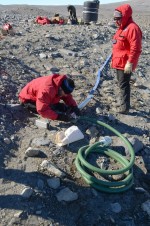Scientists expect the impact of climate change to be amplified in Polar regions because of the sensitivity of the cryosphere to the phase change of ice to liquid water. For example, in the Artic climate change is manifest in the decreasing extent of summer sea ice and widespread thawing of permafrost. Such events are both sentinels of anthropogenic climate change as well as drivers of changing ecosystem structure and functioning. The thawing of permafrost contributes to significant changes in soil hydrology, biogeochemical cycling, and in the activity and composition of soil communities. While climate warming can elicit such responses over years to decades, thawing occurs quickly and completely.
In Antarctica, scientists at the McMurdo Dry Valleys (MCM) Long Term Ecological Research (LTER) program observed abrupt changes in community structure and biogeochemical cycling in terrestrial and aquatic ecosystems following a record warm summer in January 2002. The resulting thaw was especially significant as it occurred at the end of a decade-long cooling period, during which summer glacial melt decreased and aquatic and terrestrial productivity and populations of dominant biota were suppressed. The Dry Valleys ecosystems’ response to the melt exceeded the effects of the decades long cooling in both magnitude and rate of hydrological and ecological responses. Thus, LTER scientists anticipate that climate-induced permafrost changes and their associated impacts on soil communities and biogeochemical cycles may occur over shorter time scales as distinct melt and thaw events.
To better understand this phenomenon, the MCM LTER project has initiated an experiment to manipulat hillslope soils to simulate different frequencies of permafrost thaw and to study their impacts on soil physical and biological properties. MCM scientists have been studying the soil communities, surface geochemistry and hydrology of hillslopes near Many Glaciers Pond in eastern Taylor Valley, Antarctica, collecting initial data on microclimate, water content, nutrient cycling, and invertebrate and bacterial communities.
During the first week of January 2014 the scientists applied 1500 liters of sterilized water to two experimental plots adjacent to an undisturbed reference plot. The water was applied to trenches excavated to the depth of the ice-table located uphill from the instrumented plots. Since the top horizons of most Antarctic soils are dry permafrost with insufficient water content to generate ice cement, thawing is likely to result in subsurface movements of water that manifest as groundwater seeps or water tacks. The water additions are intended to simulate subsurface thaw and, indeed, automated water sensors detected significant pulses of water moving downhill from the point of application in the weeks following the start of the experiment.
In subsequent years MCM scientists will continue to simulate permafrost thaw and to test the hypotheses that the movement of subsurface water when permafrost thaws has a homogenizing effect on the distribution of nutrients, salts in the soil, and soil communities, and a stimulating effect on the populations of certain soil organisms.

 Enlarge this image
Enlarge this image

